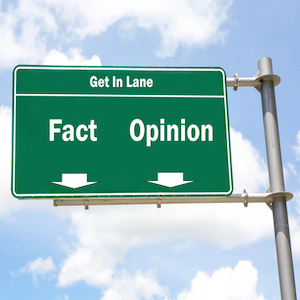By Dr. Ken Broda-Bahm:

The distinction between what is fact and what is opinion is arguably one of the most fundamental distinctions in law. But in practice, it is actually a lawyer’s distinction. In the real world, and in the minds of many jurors and some judges, facts and opinions end up being combined and mixed. The eyewitness talks about the quality of his perceptions, and the witness who describes the company’s testing procedures will also comment on the sufficiency of those efforts. The legal standards limit how much a fact witness can share those opinions, but a belief that the fact witness is going to be restricted — as the name suggests, to “just the facts, ma’am” — is harder to enforce when it comes to practical testimony. Like many other legal dichotomies, the fact/opinion distinction can crumble when it comes to application.
Current research coming out of Canada provides more reason to doubt that practical distinction when it comes to assessing testimony, and to believe that a mixture may be beneficial in some ways. The researchers (MacLean & Miller, 2024) looked at workplace investigations and ran an experiment finding that a witness’s non-factual statements have a substantial effect on the interpretation and acceptance of evidence. In this post, I’ll take a look at that research and what it has to say about our ability to rely on and enforce a distinction between facts and opinions.
The Research: Opinions Mix With Facts
The researchers begin with the idea that a witness’s familiarity with the facts will often lead to the inclusion of background information including opinions or interpretations that link the facts together. Observers will quite often have a theory about what the facts mean to them, and that theory ends up being delivered along with the facts. In addition, confirmation bias that leads us to retain and emphasize some facts over others.
Testing a scenario (a forklift and pedestrian collision) in a workplace investigation context, the research participants received witness statements and assessed the credibility and utility of those statements. The descriptions included the same basic facts, half contained “uncheckable” opinions while the other half included neutral statements. The test was whether the inclusion of opinion statements (“he is sloppy”) would interact with the factual statements about the forklift driver’s record. The researchers found that the opinions significantly biased participants’ interpretation of the facts. “In sum, uncheckable content significantly biased participants’ impressions of the certainty of the witness, as well as their determination of event cause.”
The Implications: Don’t Rely Too Heavily on a Juror’s Ability to Untangle Them
There may be situations where opinions are something you want to play up, play down, or exclude. In thinking how jurors are likely to process these strategies, there are a few things to keep in mind.
Jurors Won’t Easily Distinguish Between Opinions and Facts
The researchers report on a line of studies showing that people don’t readily differentiate between facts and opinions. For most of us, the distinction between “what I agree with” and “what I disagree with” is far more salient. They found that in the present study as well: when research participants received opinions, they were likely to misclassify those opinions as facts, particularly when they resonated with what was already believed. This underscores the self-serving tendency to think that what supports our views are facts, while the refutations are mere opinions.
Opinions End Up Reinforcing Facts
The researchers also cite studies showing that opinions make up a substantial portion of witness statements: 19 percent to 32 percent. It is likely that there is a reason for that. People are not just cameras recording experiences for later recall. Instead, we are integrating and finding meaning from what we experience. As the team notes, people develop theories about what facts mean and what knits them together. It is inevitable that those theories will be part of even a strictly factual presentation. If the theories help the interpreter to make sense of a situation, then they’re likely to help the listener as well.
When Fact Witnesses Slip In Opinions, It Can Improve the Testimony
The finding from the study was that mixing opinion into factual testimony led participants to see the witness’s testimony as more factual and more diagnostic, particularly when the observers consider the opinion to be consistent with their own hypotheses. That means that “what did you think about that?” questions may be part of a complete picture. While under the rules of evidence, fact witnesses cannot share what would be expert opinions, they can share opinions that are rationally based on the witness’s perceptions. What the study shows is that this tends to help make the testimony more influential.
____________________
Other Posts on Testimony:
- Wake Them Up: 9 Ways to Make Testimony More Engaging for Jurors
- Expect a Complex Response to Emotional Testimony
- Testimony Mode: Note the Tradeoff Between Information Density and Juror Sensitivity
____________________